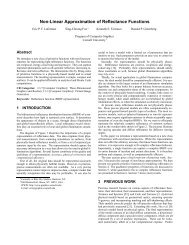pigmented colorants: dependence on media and time - Cornell ...
pigmented colorants: dependence on media and time - Cornell ...
pigmented colorants: dependence on media and time - Cornell ...
You also want an ePaper? Increase the reach of your titles
YUMPU automatically turns print PDFs into web optimized ePapers that Google loves.
visible spectrum are increasing at different rates. Yet, underst<strong>and</strong>ing the effect <strong>on</strong><br />
percepti<strong>on</strong> of n<strong>on</strong>uniform changes in the spectral distributi<strong>on</strong> is more complicated<br />
than with uniform changes.<br />
Hue shifts occur when spectral distributi<strong>on</strong> reflectance curves change unequally<br />
with respect to wavelength. The color of a material depends <strong>on</strong> both the light that<br />
is reflected <strong>and</strong> light that is absorbed. First, a n<strong>on</strong>linear increase in a material’s<br />
reflectance affects the appearance. For instance, increasing a material’s reflectance<br />
between 565 − 590nm will in turn reflect more yellow light back into the envir<strong>on</strong>-<br />
ment. As a result, the viewer will see the material as being yellower.<br />
The sec<strong>on</strong>d case is slightly less intuitive. For instance, oil paints typically<br />
experience a slight yellowing of the binding material due to oxidati<strong>on</strong>. This equates<br />
to a drop in the lower regi<strong>on</strong>s of the spectral reflectance curve. Then, the material<br />
is absorbing more blue light than previously. In other words, the material is<br />
thus reflecting less blue light back toward the viewer. Therefore, the material is<br />
reflecting relatively more yellow light <strong>and</strong> hence appears to have yellowed.<br />
In both cases, a hue change is dependent <strong>on</strong> the relative balance between light<br />
reflected <strong>and</strong> absorbed. A n<strong>on</strong>uniform change in either can affect the overall per-<br />
cepti<strong>on</strong> of a hue.<br />
It is worth menti<strong>on</strong>ing that in paint, what we perceive as hue shifts typically<br />
occur when a n<strong>on</strong>linear change occurs away from the central tendency of the ma-<br />
terial’s reflectance. For instance, we typically state that a blue has yellowed, or<br />
a purple shifted toward red, etc. However, when these changes occur near the<br />
central tendency of the reflectance, the perceptual change is not that of hue, but<br />
of chroma.<br />
180<br />
C<strong>on</strong>sider the previous case of Lapis Lazuli in gouache. As the paint evolves,



